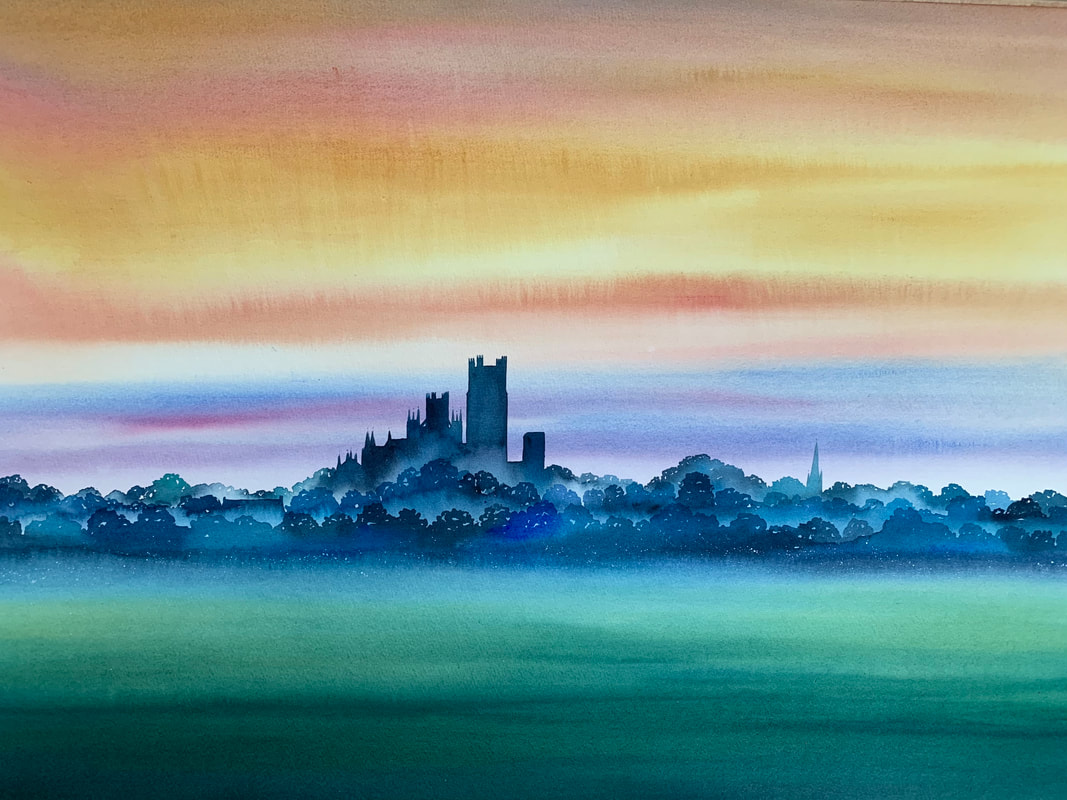Ely Cathedral by Ian Scott Massie
Original Watercolour
28" x 36" Mounted size - 22" x 30" Image size
Available: unframed @ £1895
To shop, please click here
28" x 36" Mounted size - 22" x 30" Image size
Available: unframed @ £1895
To shop, please click here
ST ETHELDREDA
I first saw Ely from a train. The wide fens stretched away under the enormous sky and, in the distance, the misty shape of the cathedral appeared like a wraith. I was captivated. I’d read the legends of Hereward the Wake who led resistance to the Norman invasion from his base at Ely. The cathedral, as I saw it that day, fitted my imagined background to the story perfectly.
Ely Cathedral, began as an abbey founded by Saint Etheldreda in 672. The elegant church, frequently cited as one of the most beautiful of English cathedrals, sails serenely over the level landscape earning its soubriquet “The Ship of the Fens”.
There was a pious king of East Anglia, King Anna, who had a daughter in about 633. Etheldreda took a vow of chastity at an early age and remained a virgin on her marriage to a nobleman of the Fens. Her dowry was the Isle of Ely - the place of eels. Her husband died after three years of marriage. She married a second time to the future King Egfrith of Northumbria and dedicated herself to encouraging the spirituality of the Northern church working alongside saints Cuthbert and Wilfred. She helped found Hexham monastery and visited Whitby abbey where her relative, St Hilda, was abbess.
As time passed Egfrith began to demand a child. To preserve her chastity Etheldreda fled south disguised as a beggar and dispensing miracles on the way: controlling the tides, creating a holy spring and turning her staff into a tree. At last she reached Ely and founded a double monastery for monks and nuns, becoming the first abbess. She only wore wool, took cold baths and ate one meal a day. After her death many miracles were credited to her and an annual fair, using her shortened name of Audrey, was held at which cheap necklaces - St Audrey’s Laces - were sold. From this developed the word “tawdry” for something poor quality and tasteless.
She is remembered as a miraculous curer of headaches, throat diseases and blindness.
Ely Cathedral, began as an abbey founded by Saint Etheldreda in 672. The elegant church, frequently cited as one of the most beautiful of English cathedrals, sails serenely over the level landscape earning its soubriquet “The Ship of the Fens”.
There was a pious king of East Anglia, King Anna, who had a daughter in about 633. Etheldreda took a vow of chastity at an early age and remained a virgin on her marriage to a nobleman of the Fens. Her dowry was the Isle of Ely - the place of eels. Her husband died after three years of marriage. She married a second time to the future King Egfrith of Northumbria and dedicated herself to encouraging the spirituality of the Northern church working alongside saints Cuthbert and Wilfred. She helped found Hexham monastery and visited Whitby abbey where her relative, St Hilda, was abbess.
As time passed Egfrith began to demand a child. To preserve her chastity Etheldreda fled south disguised as a beggar and dispensing miracles on the way: controlling the tides, creating a holy spring and turning her staff into a tree. At last she reached Ely and founded a double monastery for monks and nuns, becoming the first abbess. She only wore wool, took cold baths and ate one meal a day. After her death many miracles were credited to her and an annual fair, using her shortened name of Audrey, was held at which cheap necklaces - St Audrey’s Laces - were sold. From this developed the word “tawdry” for something poor quality and tasteless.
She is remembered as a miraculous curer of headaches, throat diseases and blindness.




